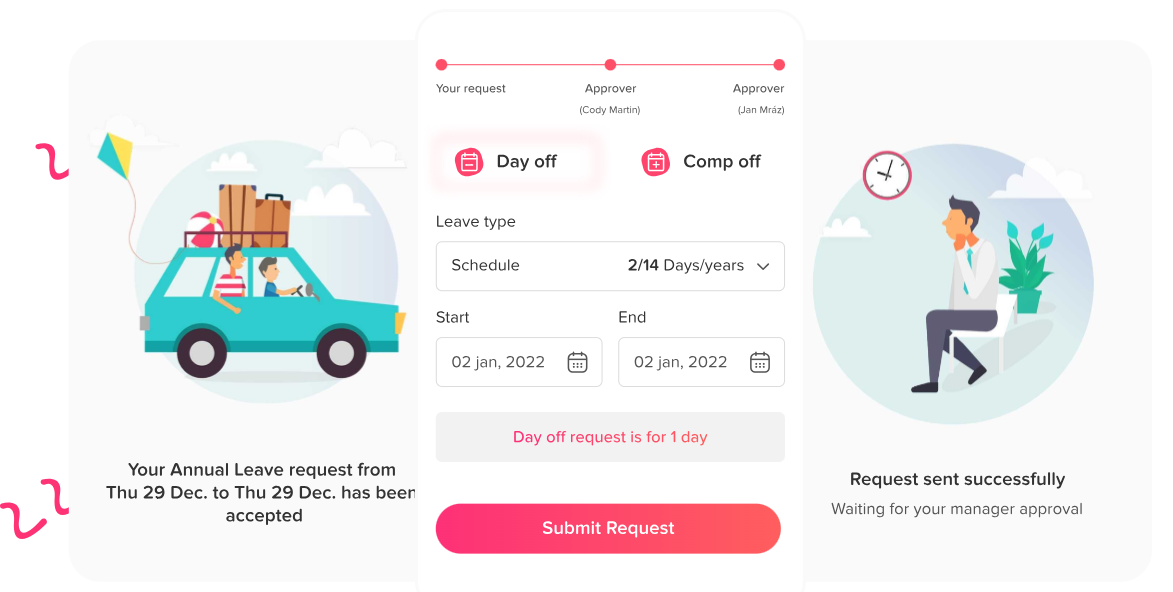Effective leave management is crucial for maintaining a balanced and productive workforce. Implementing a system to track day off not only ensures operational efficiency but also supports employee well-being by recognizing their need for rest and personal time. In this article we will talk about features of day off tracking systems that can help you track your team’s leaves and absences in one place. In seconds you will set up your leave policies, approval workflow and enjoy a unique experience.
Day Off is built to suit different business types, allowing every HR manager to plan, track, and manage employees’ leaves and PTO.
Day Off Features
1.Automated Leave Request and Approval Workflow
A key feature of any day off tracking system is an automated request and approval workflow. This allows employees to submit leave requests digitally, then automatically routed to their managers or the HR department for approval. reducing paperwork and minimizing the chances of errors. It also speeds up response times, ensuring employees can plan their time off more effectively.
2.Real-time Leave Balance Tracking
Real-time visibility into leave balances is crucial for both employees and employers. day off tracking system provide up-to-date information on how many leave days an employee has taken and how many are remaining. This transparency helps employees make informed decisions about their time off and assists HR in monitoring leave patterns and planning for absences.
3.Integrations
Integrating day off tracking system with Google Calendar, Outlook Calendar and Slack.
4.Blockout Dates
This feature can be used when HR wants to control the number of leave requests can be submitted on a specific period of time, or even turn off leave requests on this period, and block it out so employees won’t be able to submit a leave request.
5.Customizable Leave Policies
Different organizations, and sometimes different departments within the same organization, may have unique leave policies. Day off tracking system allow customization accommodate various leave types such as vacation, sick leave, personal days, PTO and public holidays.
It enables the creation of rules regarding accrual rates, carryover policies:
- Setting accruals: if you want leave balance to be divided to the employee (monthly, biweekly, weekly) and to not get the total balance on one time on the renewal date.
- Setting carryover: employee can carry over his remained off days in the leave balance to the renewed balance.
6.Mobile Accessibility
With the increasing adoption of remote work and the need for flexibility, having mobile access to the day off tracking system is indispensable. Employees should be able to request time off, check their leave balances, and receive notifications on their mobile devices. Similarly, managers should be able to approve requests and view team leave schedules from anywhere, at any time. Day Off is available on IOS and Android mobile application.
7.Reporting and Analytics
Reporting and analytics capabilities can transform how organizations manage time off. By analyzing leave trends, HR can identify patterns such as peak leave periods. This data can inform staffing decisions, improve workforce planning, and contribute to developing policies that support employee well-being. Day off is supporting Reports feature to track your team’s balance.
8.Employee Self-Service Portal
Employee self-service portal empowers staff to manage their leave requests independently, access their leave history, and view their leave policies. This not only enhances the employee experience by providing control and transparency but also reduces the administrative burden on HR departments.
Conclusion
Day off tracking system with these features can significantly improve leave management processes, benefiting both the organization and its employees. By automating workflows, providing real-time insights, and offering flexibility and transparency, companies can ensure a smooth operation while supporting their employees’ need for work-life balance. As always, it’s important to choose a system that aligns with your organization’s specific needs and to consult with HR professionals to ensure the chosen solution complies with local regulations and best practices.
